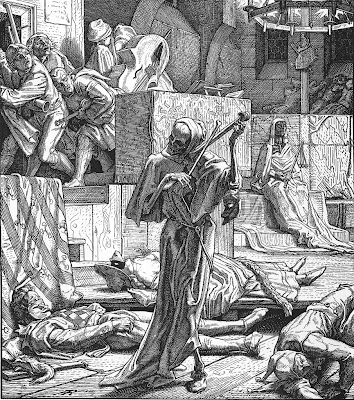Not only the plague provided an opportunity for the creation of new representation of Death. At the 19th century, another illness infected Europe in waves: the cholera. Rethel drew Death as a cutthroat, and engraved it later, since woodcut was a very popular genre at this time. He was inspired by by an account that the celebrated poet Heinrich Heine had made of the sudden outbreak of cholera in the year 1832, at a masquerade during the carnival of Paris. Here, Death plays a kind of violin, while the musicians flee. Close to them,stands a emaciated female silhouette, wrapped in a shroud: symbol of the disease. In the foreground, some people have already died of the cholera. (la mort dans l'art)
Now proving himself the service of death, serious and thoughtful, as a compassionate and trusted friend, because he knows he brings to the weary age blessed rest and eternal peace.
Rethel also executed a powerful series of drawings "The Dance of Death" suggested by the Belgian insurrections of 1848. This work was inspired by the bloody repression of the revolution of 1848, it represents Death as the leader and the only winner of this battle. Rethel had lived the revolution as a kind of dance of Death, as formerly the artists had lived the plague. The work had an immense influence, as well abroad as in Germany (la mort dans l'art) :
 Plate 1 (Resurrection of death)
Plate 1 (Resurrection of death)Vanity, deceit, lies and the evil desires in upgrading siren shape her knight, death, with the attributes of justice tied to the doom of man.
 Plate 3 (Incitement to rebellion)
Plate 3 (Incitement to rebellion)In front of the inn, he arouses the people against the rulers, by weighing up a crown and a pipe stem, grinning to today.
 Plate 4 (The sword of death presented to the people)
Plate 4 (The sword of death presented to the people)As benefactors, he goes to the mob, the barricades erected, his sword for self-help.




















.jpg)




Δεν υπάρχουν σχόλια:
Δημοσίευση σχολίου